Follow TheFugitive for all the latest bodybuilding news, product reviews and tips on living a healthy life
TheFugitive

Thursday, February 28, 2013
Wednesday, February 27, 2013
Gamma Labs Renews Deal with UFC Ring Girl Brittney Palmer
Gamma Labs announced today it will renew its contract with Ultimate Fighting Championship’s octagon girl Brittney Palmer as their Brand Ambassador.
 Palmer originally signed on as Gamma Labs’ Brand Ambassador in July of 2011. She is one of the brand’s most recognizable and widely marketed personalities. Following her new contract, fans will continue to see Palmer in Gamma Labs gear through the summer of 2014.
Palmer originally signed on as Gamma Labs’ Brand Ambassador in July of 2011. She is one of the brand’s most recognizable and widely marketed personalities. Following her new contract, fans will continue to see Palmer in Gamma Labs gear through the summer of 2014.
“We are very excited to announce that Brittney will continue to be a part of the Gamma Labs family,” said Clifford Morgan, Chief Executive Officer of Gamma Labs. “She has been an integral part of the Gamma Labs expansion and we are excited for what the future holds.”
Palmer’s professional modeling career started when she was 18 as she stole the spotlight in numerous shows in her hometown of Las Vegas. She became involved with UFC as an octagon girl in 2008. Due to her unique perspective and allure Palmer stands out amongst her peers.
Palmer will be featured on this month’s cover of the Turkish edition of FHM magazine, and has appeared in all aspects of media with over millions of viewers. Most of her free time is dedicated to her extreme passion for art. A self-taught painter, Palmer currently attends art school at UCLA to pursue her career.
(Watch the video online on Gamma Labs TV at: http://youtu.be/lUaWqJCngkU)
Gamma Labs is the makers of the new G Fuel energy drink which offers athletes and video gamers a natural energy enhancement without the crash that occurs with other energy drinks.
For more information on Brittney Palmer, other Gamma athletes or Gamma Labs products, go to www.gammalabs.net or visit the Gamma Labs TV channel on YouTube.
About Gamma Labs: Gamma Labs was established in 2004 for a single reason—to find the healthiest, most effective way to enhance athletic performance using 100% natural, legal, and effective formulas. The team behind Gamma Labs consists of real athletes who use the products every day and who are committed to developing safe, highly effective, all-natural supplements formulated out of the latest scientific expertise and manufactured to the highest levels of pharmaceutical standards. Each of the company’s products comes with a 100% unconditional money back guarantee.
Thermic Burn
By Mike Roussell Ph.D.
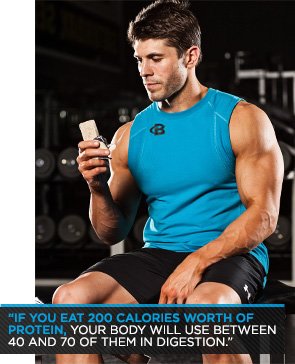

What the heck is the thermic effect of food, how big of an impact does it have, and can I harness it to work for me as I try to build lean mass?
The thermic effect of food is the caloric cost of digesting and processing different macronutrients in your diet. There is evidence that scientists have known about this phenomenon since the early 1900s. Amazingly, despite what we could consider greatly antiquated methods, researchers over 75 years ago were able to accurately determine the different thermic effects of each of the different macronutrients.

Understand that there are no hard-and-fast values for the thermic effect of the different macronutrients, because research shows slightly different results from study to study. Granted that, here are some generally accepted parameters:
- Protein: 20-35% of calories burned through processing
- Carbohydrates: 5-15% of calories burned through processing
- Fats: 0-5% of calories burned through processing
To put this in tangible terms, if you eat 200 calories worth of protein, your body will use between 40 and 70 of them in digestion. The most common estimate for the total thermic effect of food is around 10 percent of your total caloric intake, but as your protein intake increases so does this number.
Put Information to Work ///
The thermic effect of food should be particularly of interest to hardgainers or anyone trying to add mass. Hardgainers are generally metabolically inefficient, meaning their bodies burn off excessive amounts of calories as heat—and thus not for processes like muscle-building. This requires them to eat even more than their non-hardgainer counterparts in order to put the same number of calories effectively to use.
A struggling hardgainer eating 3,300 calories per day on a 40/30/30 protein/carb/fat breakdown could be burning off as much as 365 calories due to the thermic effect of food. That is a significant chunk of calories. Accounting for these caloric losses can make life less frustrating, because it provides a more accurate picture of the calories being directed toward muscle-building efforts. Since protein has a thermic effect upward of five times greater than carbohydrates or fat, the additional calories you put into your diet to make up for this gap should come from carbohydrates, fats or both. This will minimize the thermic consumption.

Other factors affect the thermic effect of food in ways which could be of great interest to hardgainers and anyone else who tracks and strategizes their macro intake. These are exercise and body composition. People who are lean have been shown to experience a greater thermic effect, although there's no clear consensus on how much. Likewise, the thermic effect of food jumps post-exercise, but again, since this is tied to body composition, exercise duration, and intensity, it is difficult to give a clear estimate of how much.
So what's the takeaway? If you add extra calories during the post-workout window to take advantage of insulin sensitivity, it may work against you to some degree if your goal is to build mass. To counteract this increase in the thermic effect of food, consider adding fat or carbohydrate calories strategically outside of the post-workout window.
Tuesday, February 26, 2013
Virus To Treat Prostate Cancer

From Science Daily
A recombinant Newcastle disease virus kills all kinds of prostate cancer cells, including hormone-resistant cells, but leaves normal cells unscathed, according to a paper published online ahead of print in the Journal of Virology. A treatment for prostate cancer based on this virus would avoid the adverse side effects typically associated with hormonal treatment for prostate cancer, as well as those associated with cancer chemotherapies generally, says corresponding author Subbiah Elankumaran of Virginia Polytechnic Institute, Blacksburg. The modified virus is now ready to be tested in preclinical animal models, and possibly in phase I human clinical trials.
Newcastle disease virus kills chickens, but does not harm humans. It is an oncolytic virus that hones in on tumors, and has shown promising results in a number of human clinical trials for various forms of cancer. However, successful treatments have required multiple injections of large quantities of virus, because in such trials the virus probably failed to reach solid tumors in sufficient quantities, and spread poorly within the tumors.
The researchers addressed this problem by modifying the virus's fusion protein. Fusion protein fuses the virus envelope to the cell membrane, enabling the virus to enter the host cell. These proteins are activated by being cleaved by any of a number of different cellular proteases. They modified the fusion protein in their construct such that it can be cleaved only by prostate specific antigen (which is a protease). That minimizes off-target losses, because these "retargeted" viruses interact only with prostate cancer cells, thus reducing the amount of virus needed for treatment.
Retargeted Newcastle disease virus has major potential advantages over other cancer therapies, says Elankumaran. First, its specificity for prostate cancer cells means it would not attack normal cells, thereby avoiding the various unpleasant side effects of conventional chemotherapies. In previous clinical trials, even with extremely large doses of naturally occurring strains, "only mild flu-like symptoms were seen in cancer patients," says Elankumaran. Second, it would provide a new treatment for hormone-refractory patients, without the side effects of testosterone suppression that result from hormonal treatments.
About one man in six will be diagnosed with prostate cancer, and one in 36 will die of this disease. Men whose prostate cancer becomes refractory to hormone treatment have a median survival of about 40 months if they have bone metastases, and 68 months if they do not have bone metastases.
Sunday, February 24, 2013
Saturday, February 23, 2013
Red Meat Protein vs Dairy Protein
Proteins, despite being grouped within a single classification, are some of the most versatile molecules on Earth. The building blocks of proteins are called amino acids. Their arrangement determines the composition and attributes of proteins. Twenty amino acids exist in nature, and most proteins contain tens or hundreds of amino acids, allowing for a staggering number of possible combinations. This versatility means that dairy and red meat proteins can differ significantly in their quality.
According to the Food and Agricultural Organization of the United Nations and the World Health Organization, the protein digestibility-corrected amino acid score, or PDCAAS, is the best method for evaluating protein quality based on the amino acid requirements of humans and the ability to digest protein. The PDCAAS is 121 for cow's milk but only 92 for beef, a common red meat. However, some measurements truncate the PDCAAS at 100 percent, arguing that any protein beyond this threshold also exceeds the typical amino acid requirements for humans. Up until around 1993, the protein efficiency ratio, or PER, which measures the ability of protein to support growth, was a popular method of determining protein quality. Cow's milk has a PER of 3.1 vs. 2.9 for beef. However, PER has two large deficiencies: first, it's a measurement of growth in rats and not humans, and second, it is less applicable to adults.
Comparison of Proteins
Both red meat and dairy contain all 20 amino acids necessary for the proper health of the human body. In this important respect, they are similar to other animal products such as eggs and poultry. However, they differ in more subtle ways. The problem with judging proteins separately is that many factors can determine protein quality, including the quantity of amino acids and the digestibility of the protein, which makes a direct comparison difficult. Dairy appears to be slightly inferior in digestibility but superior in overall amino acid value.
Amino Acid Score
Biological Value
Yet another measurement of protein quality is the biological value, which reflects the proportion of amino acids that the human body incorporates into proteins within the cells. Scientists can measure the biological value by looking at the amount of nitrogen — a distinguishing element within amino acids — that the human body retains. Milk has a biological value of 91 vs. only 80 in beef.
Milk Proteins
Milk contains two separate proteins, casein and whey. Whey alone tends to be superior to casein in most measurements of protein quality. In fact, whey is one of the best individual sources of protein. Casein, by itself, is better than red meat in some aspects, such as protein digestibility, but worse in others, such as PER. When judging dairy products, it's important to remember that cheese only contains casein. It is also possible to buy whey protein separately as a dietary supplement.
Friday, February 22, 2013
The Best BCAA Food Sources
By Mike Roussell Ph.D.
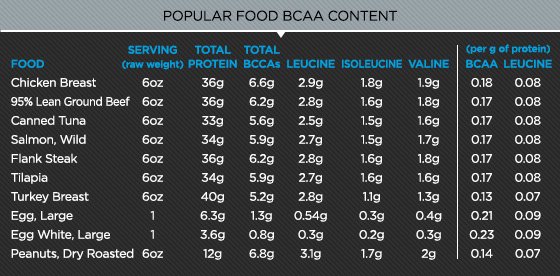

I like BCAA supplements, but I know that essential aminos are also found in many foods. What are the best dietary sources of BCAAs?
Branched-chain amino acid supplements are extremely popular for boosting protein synthesis during and after training sessions, in addition to providing a convenient between-meal spike in the muscle-building amino leucine. However, with the explosion in popularity of BCAA supplementation, the role of whole food sources of BCAAs is often overlooked.
Chewing and swallowing your aminos will never be as easy as simply mixing a powder in water. On the other hand, man cannot and should not live on supplements alone. If you're looking to up your diet's anabolic and recovery-aiding potential, check out this breakdown of the BCAA content in some popular protein sources:

This table reveals some interesting information about the BCAA content of popular foods. For example, turkey breast provides more total protein than any of the other proteins per ounce—not including eggs and egg whites, which aren't usually measured in ounces—but the smallest amount of total BCAAs. By comparison, a 6 oz serving of dry-roasted peanuts packs more leucine and total BCAAs than any of the meat sources, but not nearly as much protein.
To minimize confusion and level the playing field a bit, I included the right two columns, which allow for better comparisons from one protein source to the next. Note that per gram of protein, eggs and egg whites provide the highest levels of BCAAs. Eggs again are also marginally superior when it comes to leucine content. This should be of interest to you because leucine is the main driver of muscle protein synthesis. That said, the amount of leucine is very similar per gram of total protein in all of the foods.
Which Should I Choose? ///
Any of the foods listed above are good sources of BCAAs. Research shows that 3 grams is the approximate amount of leucine needed at a given meal to maximize muscle protein synthesis, so 6 oz of any of these meats is on the low side of what you would want to consume at a meal.

If you can stomach them, six whole eggs or nine egg whites would allow you to hit the 3 gram leucine target. On the other hand, 6 oz of peanuts may not sound like a lot, but a handful is approximately 1 oz, give or take, so 6 oz is definitely a hefty portion.
The next step for you is to look at your meal plans, calorie intake, and macro breakdowns to see if you are consuming enough of these foods per meal in order to get 3 grams of leucine per meal. If not, and you can't increase your servings of these protein foods due to calorie or macro restrictions, then consider upping your intake through BCAA supplementation.
3 Ingredient Protein Ice Cream
I love vanilla ice cream but don't eat it because it's so high in sugar and fat. Is it possible to make a healthy, high-protein version using basic ingredients?
I started experimenting with protein ice cream at proteinpow.com because I love ice cream and found the idea of eating a healthy version really exciting. I thought it would be especially good served on top of a fresh stack of post-workout protein pancakes!
I went through a lot of trials and errors with my protein ice cream, but eventually arrived at what is so far my favorite formula. The recipe is simple and calls for only three ingredients. But the best part is that it doesn't require an ice cream machine.
Are you ready to get your ice cream on?
Protein Ice Cream ///
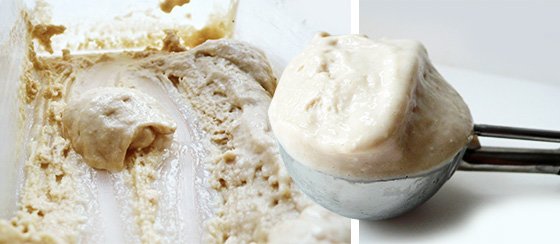
Ingredients
- 1 frozen Banana (freeze without peel)
- 300 grams Low-fat Cottage Cheese
- 1/2 cup (54 grams) Banana Flavored Whey Protein Powder
Directions
- Using a food processor, handheld blender, or mixer, blend all ingredients together. Don't use a whisk or spoon because the aim is to end up with a mixture that's creamy, not lumpy.
- Place the mixture in a Tupperware container and stick it in the freezer for an hour.
- After an hour, remove the container and give the ice cream a good stir. You want to make sure that it freezes evenly. Think of yourself as a human ice cream machine.
- Put container back in the freezer. Wait for another hour before taking it out and giving it another churn.
- Repeat steps three and four until the ice cream is nicely set and ready to be munched with gusto.
Notes:
Since there's a lot of churning involved, I like making this on the weekend. I wake up, make the mixture, stick it in the freezer, take it out to churn, put to back in, go to the gym, come back, give it another couple churns and … pow! It's ready.
Since there's a lot of churning involved, I like making this on the weekend. I wake up, make the mixture, stick it in the freezer, take it out to churn, put to back in, go to the gym, come back, give it another couple churns and … pow! It's ready.
This recipe works with casein or protein blends—it makes the ice cream even creamier! If you use other types of protein, you may have to add a couple of tablespoons of milk to the mix if it's too thick.
Try using vanilla protein powder, and try adding vanilla extract or shaved vanilla pod for an even richer vanilla flavor. You can also add some Walden Farms calorie-free caramel sauce to your ice-cream.
For an insanely tasty, guilt-free dessert, try making protein crepes and topping them with protein ice cream. It tastes like a cheat meal, but it is packed with protein!
This recipe serves two people so feel free to duplicate it. If you do, you'll just have to leave your mix in the freezer for longer so it gets the right consistency.
Nutrition Facts
Serving Size Per serving, recipe serves 2
Serving Size Per serving, recipe serves 2
Amount per serving
Calories 258
Total Fat4.8g
Total Carbs17g
Protein38g
 Protein Ice Cream PDF (69.1 KB)
Protein Ice Cream PDF (69.1 KB)Tuesday, February 19, 2013
Monday, February 18, 2013
21 Ways to Hack Your Kitchen
Good food doesn't have to cost you. Most chefs don't wield $500 Japanese knives, saute in tri-ply copper pans, or invest in high-end induction burners. They eat and drink better than we do, by improvising. Follow their lead at home. Here are 21 ways to get the job done.
1 / Jumpstart Your Oven
Stop waiting for the preheat to beep. Instead, turn on your broiler for a few minutes and then switch to the baking temperature you want. (Pro tip: This works better if your broiler unit is in your oven, not in a separate compartment.)
—Joe Yonan, author of Eat Your Vegetables: Bold Recipes for the Single Cook
—Joe Yonan, author of Eat Your Vegetables: Bold Recipes for the Single Cook
2 / Speed Up Spuds
For faster baked potatoes or sweet potatoes, start them in the microwave on high for 1 minute. Then transfer them to a preheated oven. You'll cut the time in half while maintaining the fluffy texture that only baking can provide.
—Joe Yonan
—Joe Yonan
3 / Cook and Clean with a Cordless Drill
Here are three reasons to keep this power tool handy.
Whisk!
For extra fluffy scrambled eggs, insert a whisk attachment into the drill and start beating.
For extra fluffy scrambled eggs, insert a whisk attachment into the drill and start beating.





Grind!
Unscrew the knob from the top of a pepper mill, exposing the drive shaft, and tighten the shaft into your drill. Turn on the drill to grind a pile of pepper in seconds. (Pro tip: If not enough of the drive shaft is exposed, remove the pepper mill's head.)
Unscrew the knob from the top of a pepper mill, exposing the drive shaft, and tighten the shaft into your drill. Turn on the drill to grind a pile of pepper in seconds. (Pro tip: If not enough of the drive shaft is exposed, remove the pepper mill's head.)
Scour!
Drill a quarter-inch hole into the top of a large binder clip. Insert a quarter-inch-wide, one-inch-long bolt through the hole so the threads stick out the top, and tighten a quarter-inch nut onto the bolt. Now clamp a sponge into the clip, insert the bolt into the drill, and turn on the drill to attack those pots. (Just don't scratch them with the clip!)
—Jason Poel Smith, creator of diyhacksandhowtos.com
Drill a quarter-inch hole into the top of a large binder clip. Insert a quarter-inch-wide, one-inch-long bolt through the hole so the threads stick out the top, and tighten a quarter-inch nut onto the bolt. Now clamp a sponge into the clip, insert the bolt into the drill, and turn on the drill to attack those pots. (Just don't scratch them with the clip!)
—Jason Poel Smith, creator of diyhacksandhowtos.com
4 / Thaw Food Faster
Don't place that frozen T-bone on the counter to thaw—that's how bacteria multiply. Instead, seal meat in a zip-top bag and drop it into a bowl of cold water in the sink. Change the water every half hour until the meat thaws (2-3 hours for a 3-4 pound package).
—USDA Food Safety and Inspection Service
—USDA Food Safety and Inspection Service
5 / Crisp Plate-Popping Parsley
Anyone can sprinkle herbs on a plate. For crunch (and prestige factor), make flash-fried parsley.
How to Make It: In a bowl, toss a small handful of parsley leaves with 1 tsp of canola oil. Arrange the leaves 3-4 inches apart on a paper-towel-lined plate. Microwave at 75 percent power until crispy (3-4 minutes). Let cool. Decorate your plate.
—Adapted from Nathan Myhrvold, coauthor of Modernist Cuisine
—Adapted from Nathan Myhrvold, coauthor of Modernist Cuisine

6 / Cook Quick-Peel Eggs
The more fresh your eggs, the harder they'll be to peel. Make hard-boiled eggs easy by adding a bit of baking soda to the water before you turn on the heat. The baking soda penetrates the eggs, preventing the albumin in the whites from sticking to the shells.
—Marcel Vigneron, CEO of Modern Global Tasting
—Marcel Vigneron, CEO of Modern Global Tasting
7 / Reboot Chopsticks
These takeout standbys rock at scrambling eggs, flipping bacon, and fishing food out of jars.

8 / Pick Your Needle-Nose Pliers
A (clean) pair can extract fish bones fast. Drag your finger along the bones to expose them, and then use the pliers to pull them toward the head.
—Bryan Calvert, executive chef and owner of James in Brooklyn, NY
—Bryan Calvert, executive chef and owner of James in Brooklyn, NY
9 / Go All Cheesy
Cheese is good. Melted cheese is even better. Cheese that's been sizzled to a crisp, cracker-like texture? Money.
How to Make It: Spread 2-3 tbsp of grated parmesan on a microwave-safe plate to form a 4-inch round. Microwave on 50 percent power until crispy, 60-90 seconds, and peel it off when it's cool enough to handle.
—Lachlan Mackinnon-Patterson, chef of Frasca Food and Wine, Boulder, CO
—Lachlan Mackinnon-Patterson, chef of Frasca Food and Wine, Boulder, CO
10 / Hit the Bar
Stir-frying happens quickly, but the prep work can be a slog. For any recipe that requires lots of sliced vegetables, raid your supermarket salad bar. Not only are the ingredients precut, but you can also buy the exact amount you need.
—Jeff Potter, author of Cooking for Geeks
—Jeff Potter, author of Cooking for Geeks
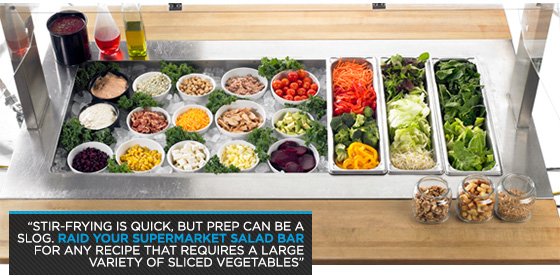
11 / Harvest Olive "Salt"
Intensify the inky color and briny kick of kalamata olives by speed-drying pitted ones in your microwave.
How to Make It: Pop a few on a plate and nuke them on high for 2-minute intervals until you can crush them between your fingers. Use the robust seasoning as a stand-in for sea salt on steak, roasted vegetables, or fish.
—Levon Wallace, executive chef of Proof on Main, Louisville, KY
—Levon Wallace, executive chef of Proof on Main, Louisville, KY
12 / Rock the 5-in-1 Tool
Next time you're hungry, dig this multi-use painting gear out of your toolbox.
Half-Round
Use it to clean grill grates. Its angles reach places a large grill brush can't.
Use it to clean grill grates. Its angles reach places a large grill brush can't.
Gouger
Use it to pop a small hole on the top of a metal olive oil jug so pouring goes more easily.
Use it to pop a small hole on the top of a metal olive oil jug so pouring goes more easily.
Scraper/Putty Spreader
Use it, along with a dose of elbow grease, to remove the baked-on crud from pots or baking sheets.
—Mike Lata, chef/owner of FIG and The Ordinary, both in Charleston, SC
Use it, along with a dose of elbow grease, to remove the baked-on crud from pots or baking sheets.
—Mike Lata, chef/owner of FIG and The Ordinary, both in Charleston, SC
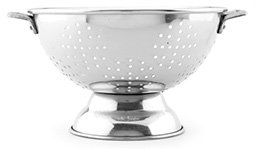
13 / Call on the Colander
To fry bacon without the splatter, position an inverted metal colander over the pan as it cooks.
14 / Clean Up with Salt
When your exuberant buddy spills red wine (or red sauce) on your shirt, it's time to take action. Remove the shirt, lay it flat, and pour salt on the stain. Wait 2 or 3 minutes so the salt has a chance to pull out the stain. Next, suck up the salt with a handheld vacuum and throw the shirt in the laundry. Oh, and then make your friend buy you another bottle of wine. (Make it a white.)
—Fabrizio Cercatore, pizzaiolo and co-owner of Hot Italian in Sacramento and Emeryville, CA
—Fabrizio Cercatore, pizzaiolo and co-owner of Hot Italian in Sacramento and Emeryville, CA

15 / Hyper-Decant Wine
Aerating wine opens up the vino's aroma. Oenophiles do this by pouring it into a decanter, but you can aerate with horsepower instead! Pour the wine into a blender and process it on high for 30-60 seconds. Wait for the foam to subside, and serve.
—Nathan Myhrvold, coauthor of Modernist Cuisine
—Nathan Myhrvold, coauthor of Modernist Cuisine
16 / Chill Beer Fast
Warm beer sucks. And your fridge sucks at chilling beer fast. Instead, add 1 tbsp of salt to a large bowl of ice water and drop in your bottles. Salt lowers the freezing temperature of the water, creating a more arctic environment for your brew.
—Jarrid Masse, cofounder of the Poor Porker in Lakeland, FL
—Jarrid Masse, cofounder of the Poor Porker in Lakeland, FL
17 / Recycle a Champagne Bottle
The sturdy base of an empty bottle makes a great meat mallet for creating thin cutlets. Just pound them flat between sheets of plastic wrap.
18 / "Cook" Food with Salt
Baking certain foods—like skin-on chicken, whole potatoes, and whole fish—in salt keeps them moist. In a large bowl, whisk 12 egg whites until foamy, and then stir in 2 1/2 pounds of kosher salt. (Halve this recipe if you're baking a small amount.) Spread a half-inch layer of salt mixture onto a baking sheet, add the food, and cover with another half-inch layer of salt mixture. Bake the food as usual; then let it rest 5 minutes. Crack the salt crust, brush away the excess salt, and serve.
—Technique by Chris Jaeckle, chef at All'Onda in NYC
—Technique by Chris Jaeckle, chef at All'Onda in NYC
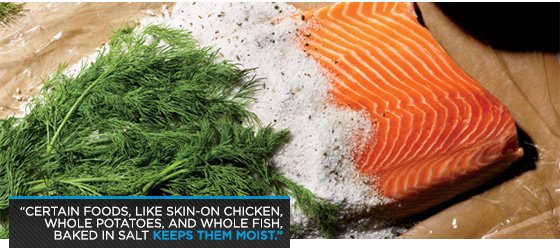
19 / Make Your Own House Salt Blend
Skip the expensive flavored salts and make your own house seasoning: Take a large, flaky salt, such as Maldon, and pulse it in a food processor with your choice of minced garlic, grated lemon peel, chopped herbs, or hot sauce—whatever flavorings you love. Then let the mixture dry on a paper towel for 12 hours. Store it in a zip-top bag or re-sealable jar and use it to season eggs, marinate chicken or pork, or finish seared steak.
—Marc Forgione, executive chef of American Cut in Atlantic City
—Marc Forgione, executive chef of American Cut in Atlantic City
20 / Sip Bar-Worthy Whiskey on the Rocks
Make ice with water from the tap and you'll end up with cloudy cubes. For crystal-clear ice, boil the water first to eliminate the dissolved gases, and let the water cool before pouring it into trays.
—Marcel Vigneron, CEO of Modern Global Tasting
—Marcel Vigneron, CEO of Modern Global Tasting
21 / Stage a Rescue Operation
If the wine cork breaks, fear not. Push the cork all the way into the bottle using the butt end of a butter knife. Then double-knot one end of a 12-inch length of twine and drop that end into the bottle. Tilting the bottle, use the knotted end to fish the cork toward the bottle's neck and then up and out.
—Jarrid Masse
—Jarrid Masse
Sunday, February 17, 2013
Six Pack Attack
By Zuzka Light

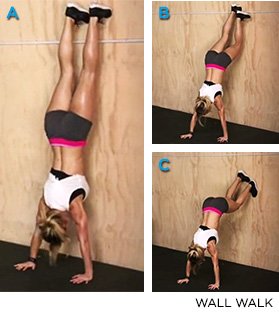
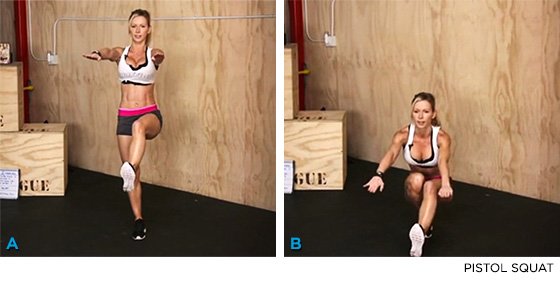
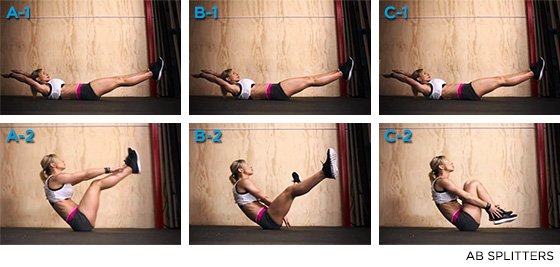
This workout is all about building core strength! Thirty minutes of crunches won't carve the abs you crave, but this high-intensity workout will produce results. Every move in this workout will target your entire core, which is exactly what you need in order to build a killer six-pack.
You need to give your maximum effort to make this workout effective. It lasts 10-12 minutes, so every repetition counts. Our minds can hold us back from giving max effort, so make sure you're mentally ready to train before you start the workout. You know you can push yourself hard for 12 minutes. Don't stop until it's over. You can do it!
Zuzka Light's Killer Core Workout
Watch The Video - 16:21
Use a timer so you can just focus on performing the movements as quickly and efficiently as possible. Keep track of how many rounds you complete so you can compete against yourself the next time you try the workout!
Zuzka Light's Killer Core Workout
In 10-12 minutes, complete as many rounds as possible of:
One-Leg Plyometric Balance /// (10 reps each leg)

Directions and Tips:
- This is a great movement for balance and core strength. It's a difficult movement to master, so make sure you practice it before you begin the workout.
- Begin balanced on your right leg. Lean your upper body forward until your left hand touches the ground and your left leg is parallel to the floor.
- After your hand touches the floor, bring your left knee forward and your upper body back to an upright position. When your body is upright, jump off your right leg and bring your left knee to your chest. As you jump off your right foot, your right arm should swing forward.

Wall Walk /// (5 reps)
Directions and Tips:
- This exercise requires you to tense your entire body. It's a great way to improve athleticism.
- Start in the push-up position with your toes touching a wall. Climb up the wall using your feet and pushing with your shoulders. You should end up in a handstand with your body a few inches away from the wall.
- Once you're in a handstand, bring your head in between your shoulders and look at the wall. This will lengthen your entire body and will engage your abs.
- Climb back down the wall by walking forward with your hands and down with your legs. Stand up completely before returning to a push-up position.
Pistol Squat /// (5 reps each leg)

Directions and Tips:
- The pistol squat is not only an awesome lower body exercise, but it's also a challenging move for your core muscles. Without engaging your core, you won't be able to do them.
- Stand on your right leg with the other straight in front of you. Bend your right leg until you're in a squat position. Keep the left leg forward.
- Try to keep your left leg out as you stand back up.
- If you are unable to do this movement, hold on to a band, bar, or use the wall for extra stability.
Ab Splitters /// (5 reps)

Directions and Tips:
- This exercise will give you that great abdominal burn you've been looking for. Make sure you keep your feet off the ground until you complete the last rep.
- Start on your back with your feet and shoulders off the ground. Keep your legs and arms straight. Bring your legs and arms up and forward. They should meet above the center of your body.
- Lay back down without resting your shoulders or feet on the ground. Once your back hits the ground, raise your upper body. As you raise your torso, split your legs. Reach your hands between your legs until they touch the ground.
- When your hands touch the ground, recline until your back touches the ground. From there, immediately incline your torso and bring your knees to your chest.
- All three movements count as one rep.
Subscribe to:
Comments (Atom)



.png)